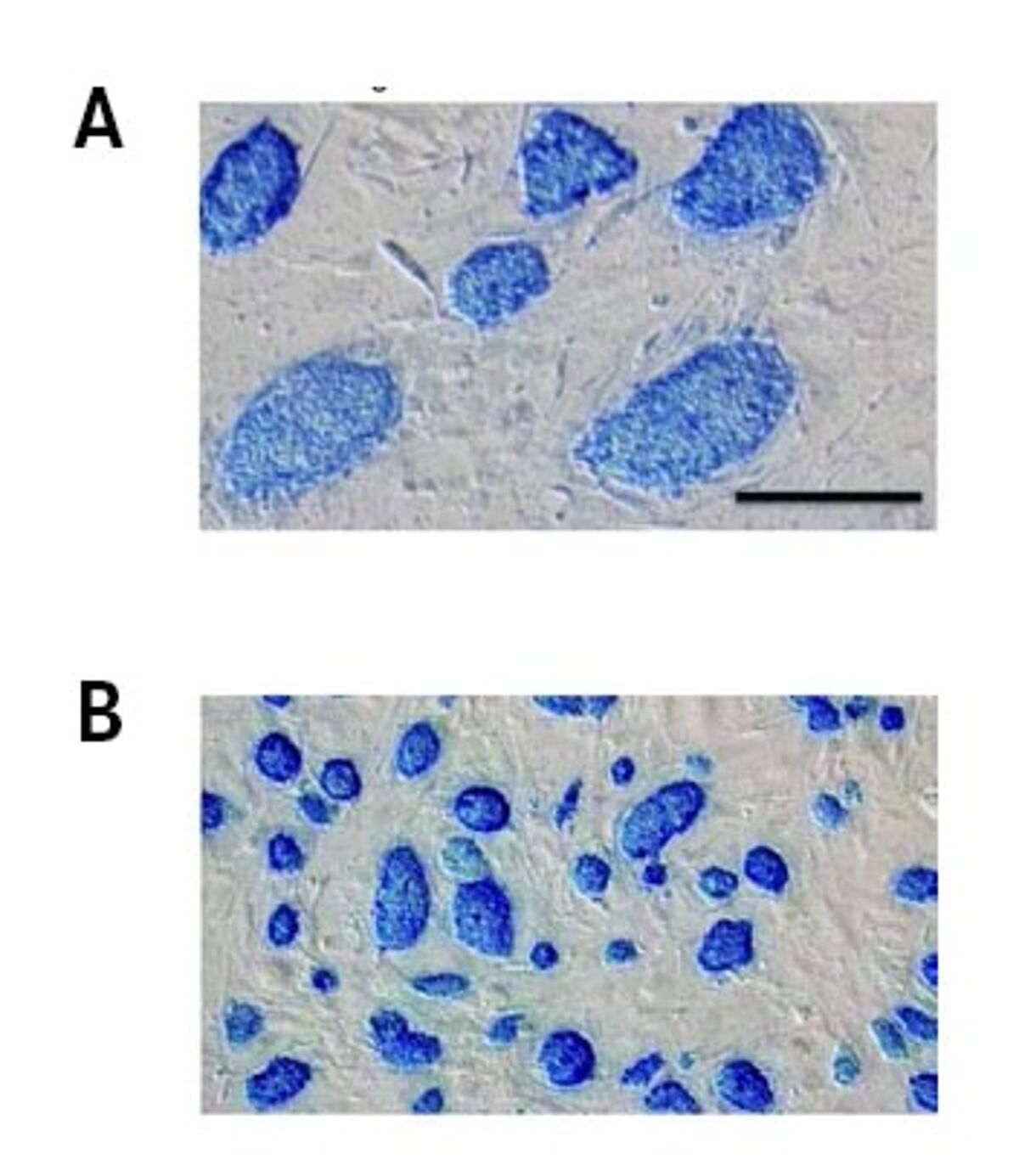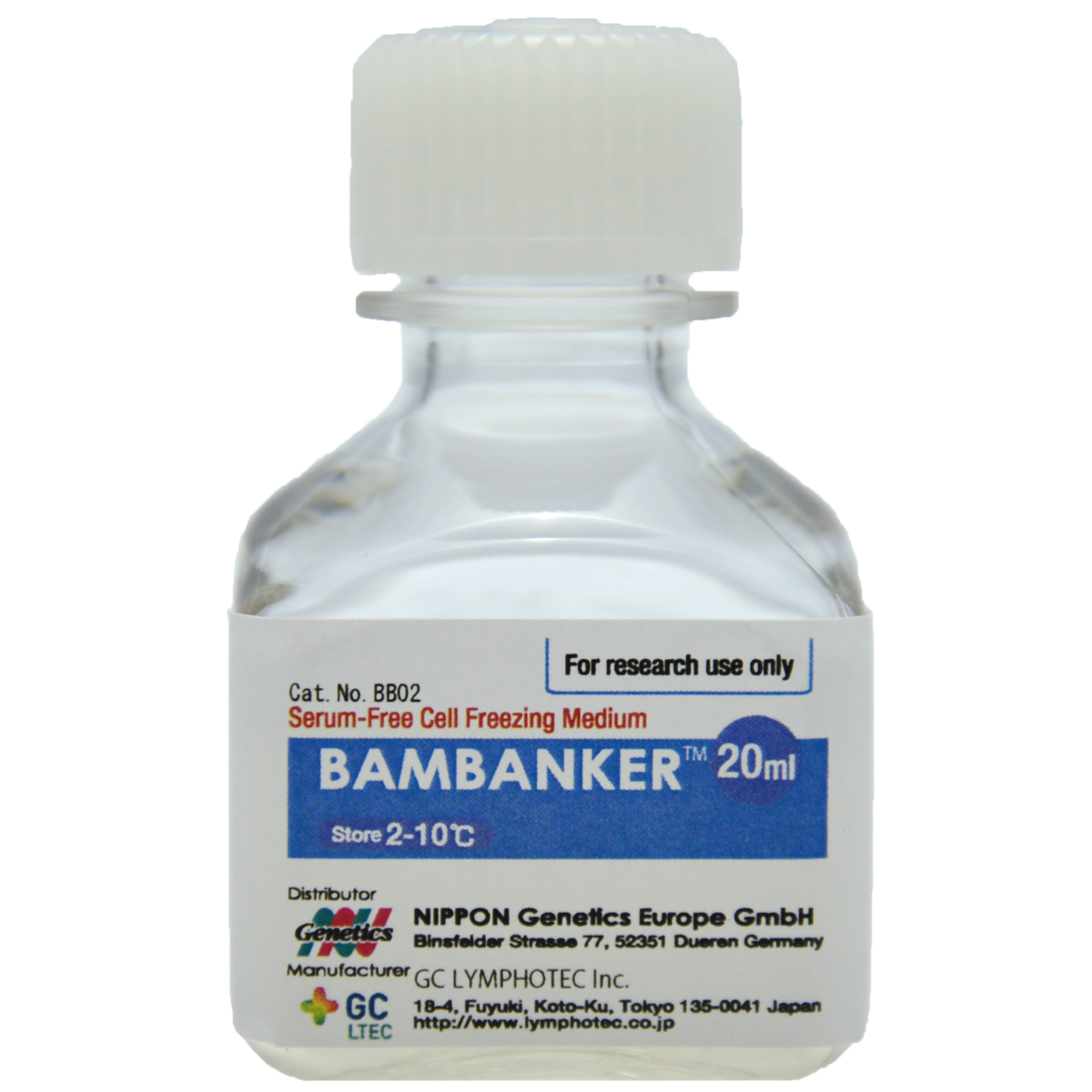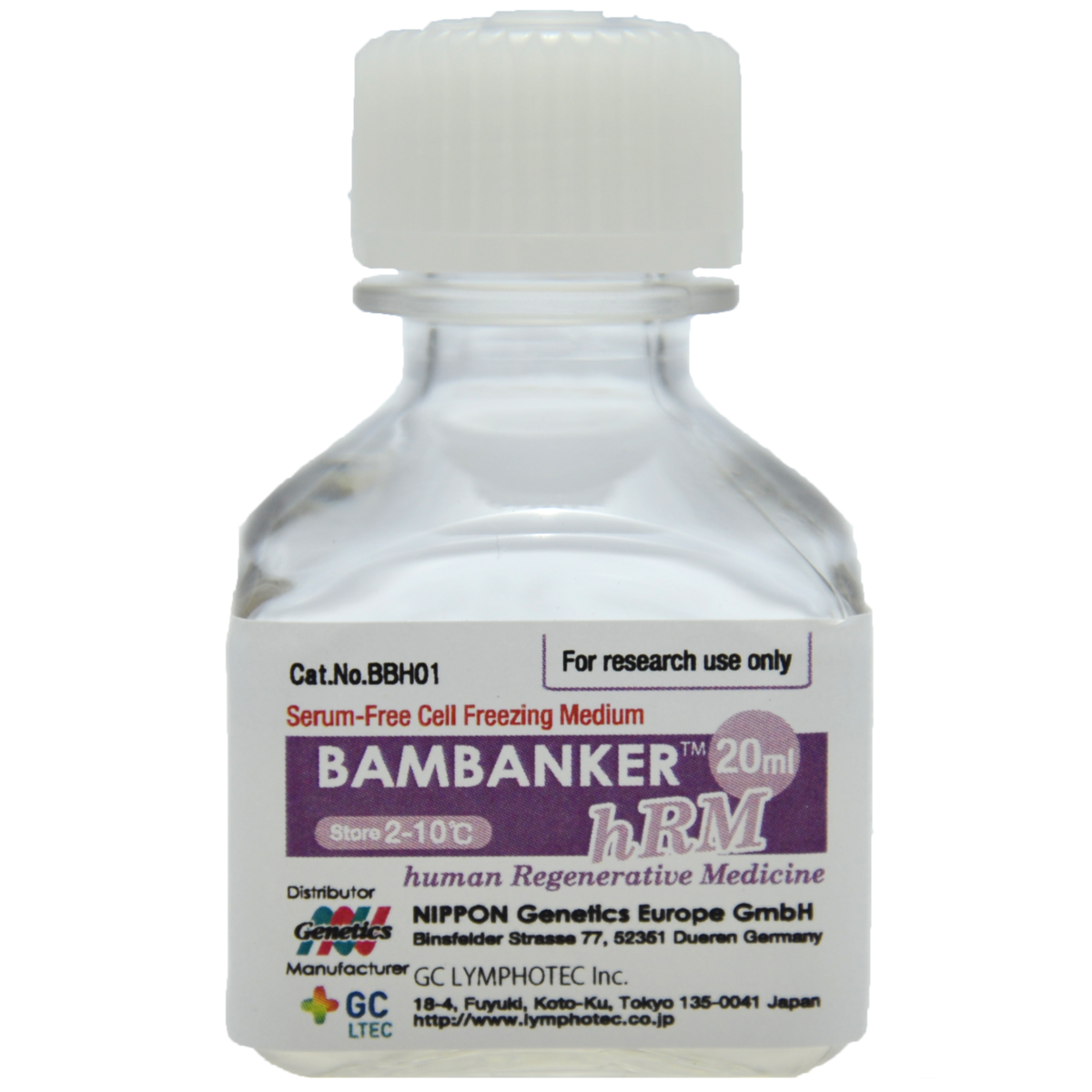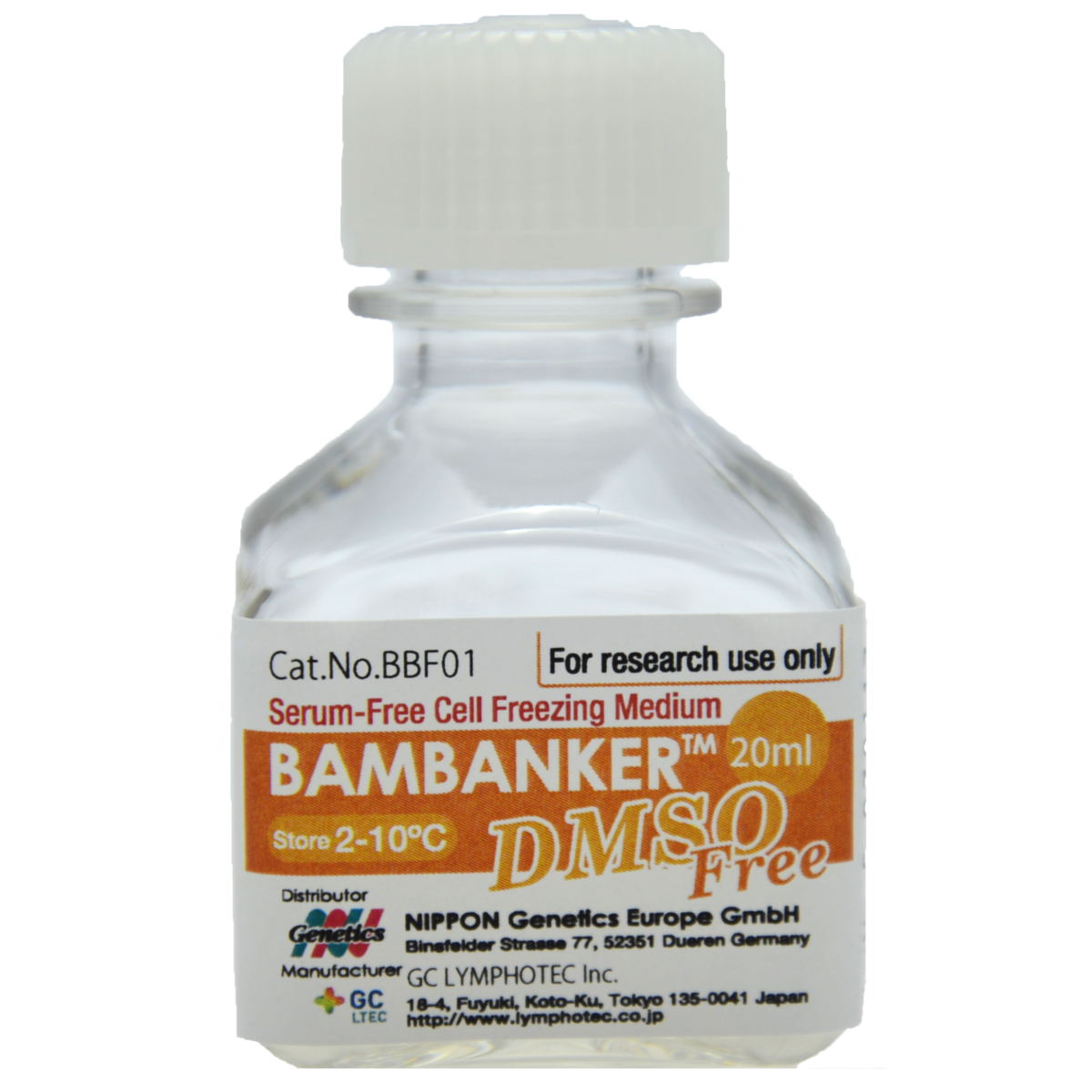Bambanker™ - the gold standard in cell freezing and storage
The Bambanker™ line of freezing media was developed for long-term storage of highly sensitive cell lines, such as primary cells, iPS cells or mesenchymal stem cells. Its innovative formulation simplifies the freezing process and greatly increases cell viability. With Bambanker™, the viability of cells during freeze/thaw cycles is greatly enhanced, even for fragile cells such as embryonic stem cells.
Advantages of using Bambanker
- Simple protocol for all cell types
- No need for step-wise freezing protocols
- Higher cell viability
- Long term storage at -80°C instead of liquid N2
Bambanker Standard
With Bambanker™ Standard, all common cell lines can be preserved resulting in a high number of intact cells after thawing. Recovery rates of even sensitive cells is much higher compared to regular media.
- No dilution and no addition of DMSO or glycerol needed
- Works with all standard cell lines
- Significantly higher viability than with standard freezing protocols
Cell lines tested successfully with Bambanker Standard
- P3U1 (mouse myeloma cell line)
- K562 (human leukemia cell line)
- Human gastric epithelial cell line
- Human γδT cell
- Daudi (human B cell line)
- PC12 (rat-derived adrenal pheochromocytoma)
- Human B cell line
- OKT4 (mouse hybridoma cell line)
- Monkey B cell line
- Mouse ES cell line
- Activated lymphocyte cell line derived from human peripheral blood
- Activated lymphocyte cell line derived from mouse spleen
- Astrocyte cell line dervied from brain tissue of newborn Wistar rats (Rattus norvegicus)
Bambanker Direct
Bambanker™ Direct is a novel cell freezing medium, which can be added directly to culture medium without centrifuging the collected cells. Cells are frozen and preserved in a deep freezer at -80 °C.
- Can be directly added to cells in medium
- No need for centrifugation
- Especially suited for hybridoma cells and HTP applications
Bambanker HRM
Cryopreservation of primate ES and iPS cells is a challenging process with the potential to harm the cells. Standard methods need extensive handling skills and often result in poor cell viability. To address these problems, the new freezing medium Bambanker™ HRM was developed, containing human serum albumin and DMSO for primate ES/iPS cells. Bambanker™ HRM provides efficient cryopreservation and dry ice transportation for primate ES/iPS cells and is xeno-free and chemically defined.
- Xeno-free freezing medium
- Made with human serum albumin
- Designed for primate ES/iPS cells
Bambanker DMSO-free
DMSO is added to freezing media in order to avoid formation of ice crystals, which harm the cells. However, DMSO is cytotoxic and reduces the survival rate of sensitive cell lines. Bambanker™ DMSO-free contains no DMSO, yet inhibits the formation of ice crystals, making Bambanker™ DMSO-free especially suitable for cell lines that are sensitive to DMSO.
- Contains no DMSO
- Serum-free
- Designed for especially sensitive cell lines
References
- Hatoya, S. et al. Effect of co-culturing with embryonic fibroblasts on IVM, IVF and IVC of canine oocytes. Theriogenology66, 1083–1090 (2006).
- Hikichi, T. et al. Differentiation potential of parthenogenetic embryonic stem cells is improved by nuclear transfer. Stem Cells25, 46–53 (2007).
- Huang, Y. H., Yang, J. C., Wang, C. W. & Lee, S. Y. Dental Stem Cells and Tooth Banking for Regenerative Medicine. J. Exp. Clin. Med.2, 111–117 (2010).
- Lechner, S. M. Interaktionen von Inseminatbestandteilen mit Epithelzellen und Leukozyten im Uterus des Rindes. (2008).
- Liu, D. et al. Relation between human decay-accelerating factor (hDAF) expression in pig cells and inhibition of human serum anti-pig cytotoxicity: Value of highly expressed hDAF for xenotransplantation. Xenotransplantation14, 67–73 (2007).
- Mieno, S. et al. Effects of diabetes mellitus on VEGF-induced proliferation response in bone marrow derived endothelial progenitor cells. J. Card. Surg.25, 618–625 (2010).
- Mieno, S. et al. Characteristics and Function of Cryopreserved Bone Marrow-Derived Endothelial Progenitor Cells. Ann. Thorac. Surg.85, 1361–1366 (2008).
- Naito, H. et al. The advantages of three-dimensional culture in a collagen hydrogel for stem cell differentiation. J. Biomed. Mater. Res. – Part A 101, 2838–2845 (2013).
- Shimizu, Y. et al. Impaired tax-specific t-cell responses with insufficient control of HTLV-1 in a subgroup of individuals at asymptomatic and smoldering stages. Cancer Sci.100, 481–489 (2009).
- Takata, Y. et al. Generation of iPS Cells Using a BacMam Multigene Expression System. Cell Struct. Funct.36, 209–222 (2011).
- Tamai, Y. et al. Potential contribution of a novel Tax epitope-specific CD4+ T cells to graft-versus-Tax effect in adult T cell leukemia patients after allogeneic hematopoietic stem cell transplantation. J. Immunol.190, 4382–92 (2013).
- Zaidi, S. K. et al. Runx2 deficiency and defective subnuclear targeting bypass senescence to promote immortalization and tumorigenic potential. Proc. Natl. Acad. Sci. U. S. A.104, 19861–19866 (2007).
- Friebel et al. Single cell mapping of human brain cancer reveals tumor-specific instruction of tissue-invading leukocytes. Cell181, 1626-1642 (2020).





